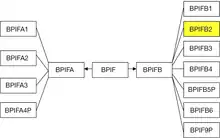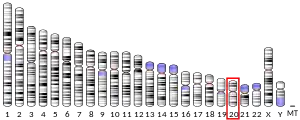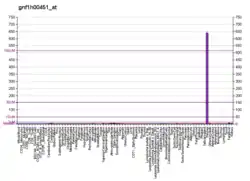BPIFB2
BPI fold-containing family B, member 2, (BPIFB2) also known as bactericidal/permeability-increasing protein-like 1, (BPI-like 1) is a protein that in humans is encoded by the BPIFB2 gene.[5][6]
| BPIFB2 | |||||||||||||||||||||||||||||||||||||||||||||||||||
|---|---|---|---|---|---|---|---|---|---|---|---|---|---|---|---|---|---|---|---|---|---|---|---|---|---|---|---|---|---|---|---|---|---|---|---|---|---|---|---|---|---|---|---|---|---|---|---|---|---|---|---|
| Identifiers | |||||||||||||||||||||||||||||||||||||||||||||||||||
| Aliases | BPIFB2, BPIL1, C20orf184, LPLUNC2, RYSR, dJ726C3.2, BPI fold containing family B member 2 | ||||||||||||||||||||||||||||||||||||||||||||||||||
| External IDs | OMIM: 614108 MGI: 1913807 HomoloGene: 11884 GeneCards: BPIFB2 | ||||||||||||||||||||||||||||||||||||||||||||||||||
| |||||||||||||||||||||||||||||||||||||||||||||||||||
| |||||||||||||||||||||||||||||||||||||||||||||||||||
| |||||||||||||||||||||||||||||||||||||||||||||||||||
| |||||||||||||||||||||||||||||||||||||||||||||||||||
| |||||||||||||||||||||||||||||||||||||||||||||||||||
| Wikidata | |||||||||||||||||||||||||||||||||||||||||||||||||||
| |||||||||||||||||||||||||||||||||||||||||||||||||||
Superfamily
BPIFB2 is a member of a BPI fold protein superfamily defined by the presence of the bactericidal/permeability-increasing protein fold (BPI fold) which is formed by two similar domains in a "boomerang" shape.[7] This superfamily is also known as the BPI/LBP/PLUNC family or the BPI/LPB/CETP family.[8] The BPI fold creates apolar binding pockets that can interact with hydrophobic and amphipathic molecules, such as the acyl carbon chains of lipopolysaccharide found on Gram-negative bacteria, but members of this family may have many other functions.

Genes for the BPI/LBP/PLUNC superfamily are found in all vertebrate species, including distant homologs in non-vertebrate species such as insects, mollusks, and roundworms.[9][10] Within that broad grouping is the BPIF gene family whose members encode the BPI fold structural motif and are found clustered on a single chromosome, e.g., Chromosome 20 in humans, Chromosome 2 in mouse, Chromosome 3 in rat, Chromosome 17 in pig, Chromosome 13 in cow. The BPIF gene family is split into two groupings, BPIFA and BPIFB. In humans, BIPFA consists of 3 protein encoding genes BPIFA1, BPIFA2, BPIFA3, and 1 pseudogene BPIFA4P; while BPIFB consists of 5 protein encoding genes BPIFB1, BPIFB2, BPIFB3, BPIFB4, BPIFB6 and 2 pseudogenes BPIFB5P, BPIFB9P. What appears as pseudogenes in humans may appear as fully functional genes in other species.
In humans, the BPIFB2 gene was first identified as a BPIL3 gene [5] whose encoded protein was called LPLUNC2 (long-palate lung and nasal epithelium clone 2),[11] but subsequently PLUNC proteins were classified as a subfamily of the BPI fold superfamily.[10] In humans, the BPIFB2 gene is found with other members of the BPI/LBP/PLUNC superfamily in a cluster on Chromosome 20.
Function
The BPIFB2 protein is involved in the innate immune response to bacterial exposure in the mucosa of the mouth, nasal cavities, and lungs, like other closely related BPIFB proteins. In particular, it is highly expressed in normal salivary glands and esophagus as well as in hypertrophic tonsils in humans.[6] In chronic rhinosinusitis BPIFB2/LPLUNC2 levels are profoundly reduced which has been interpreted as a defect in the release of glandular innate defense molecules.[12]
References
- GRCh38: Ensembl release 89: ENSG00000078898 - Ensembl, May 2017
- GRCm38: Ensembl release 89: ENSMUSG00000027481 - Ensembl, May 2017
- "Human PubMed Reference:". National Center for Biotechnology Information, U.S. National Library of Medicine.
- "Mouse PubMed Reference:". National Center for Biotechnology Information, U.S. National Library of Medicine.
- Mulero JJ, Boyle BJ, Bradley S, Bright JM, Nelken ST, Ho TT, et al. (August 2002). "Three new human members of the lipid transfer/lipopolysaccharide binding protein family (LT/LBP)". Immunogenetics. 54 (5): 293–300. doi:10.1007/s00251-002-0467-3. PMID 12185532. S2CID 11886572.
- "Entrez Gene: BPIL1 bactericidal/permeability-increasing protein-like 1".
- Beamer LJ, Carroll SF, Eisenberg D (April 1998). "The BPI/LBP family of proteins: a structural analysis of conserved regions". Protein Science. 7 (4): 906–914. doi:10.1002/pro.5560070408. PMC 2143972. PMID 9568897.
- "CDD Conserved Protein Domain Family: BPI". www.ncbi.nlm.nih.gov.
- Beamer LJ, Fischer D, Eisenberg D (July 1998). "Detecting distant relatives of mammalian LPS-binding and lipid transport proteins". Protein Science. 7 (7): 1643–1646. doi:10.1002/pro.5560070721. PMC 2144061. PMID 9684900.
- Bingle CD, Seal RL, Craven CJ (August 2011). "Systematic nomenclature for the PLUNC/PSP/BSP30/SMGB proteins as a subfamily of the BPI fold-containing superfamily". Biochemical Society Transactions. 39 (4): 977–983. doi:10.1042/BST0390977. PMC 3196848. PMID 21787333.
- Casado B, Pannell LK, Iadarola P, Baraniuk JN (July 2005). "Identification of human nasal mucous proteins using proteomics". Proteomics. 5 (11): 2949–2959. doi:10.1002/pmic.200401172. PMID 15996010. S2CID 22281622.
- Seshadri S, Lin DC, Rosati M, Carter RG, Norton JE, Suh L, et al. (July 2012). "Reduced expression of antimicrobial PLUNC proteins in nasal polyp tissues of patients with chronic rhinosinusitis". Allergy. 67 (7): 920–928. doi:10.1111/j.1398-9995.2012.02848.x. PMC 3375597. PMID 22676062.
External links
- Human BPIFB2 genome location and BPIFB2 gene details page in the UCSC Genome Browser.
Further reading
- Bingle CD, Bingle L (October 2000). "Characterisation of the human plunc gene, a gene product with an upper airways and nasopharyngeal restricted expression pattern". Biochimica et Biophysica Acta (BBA) - Gene Structure and Expression. 1493 (3): 363–367. doi:10.1016/S0167-4781(00)00196-2. PMID 11018263.
- Bingle CD, Craven CJ (April 2002). "PLUNC: a novel family of candidate host defence proteins expressed in the upper airways and nasopharynx". Human Molecular Genetics. 11 (8): 937–943. doi:10.1093/hmg/11.8.937. PMID 11971875.
- Zhang Z, Henzel WJ (October 2004). "Signal peptide prediction based on analysis of experimentally verified cleavage sites". Protein Science. 13 (10): 2819–2824. doi:10.1110/ps.04682504. PMC 2286551. PMID 15340161.
- Ramachandran P, Boontheung P, Xie Y, Sondej M, Wong DT, Loo JA (June 2006). "Identification of N-linked glycoproteins in human saliva by glycoprotein capture and mass spectrometry". Journal of Proteome Research. 5 (6): 1493–1503. doi:10.1021/pr050492k. PMID 16740002.




